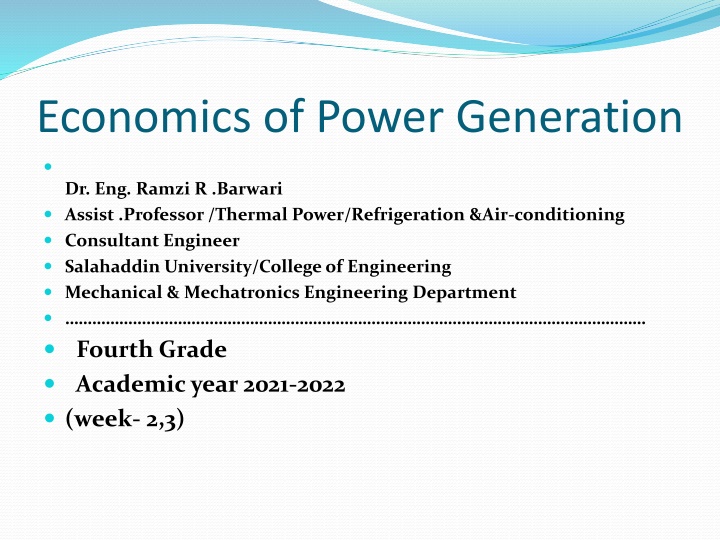
Economics of Power Generation
Learn about the economics of power generation, including factors like interest, depreciation, fixed costs, semi-fixed costs, and running costs in electricity production. Discover how the cost of electrical energy is determined and expressed in power station economics.
Download Presentation

Please find below an Image/Link to download the presentation.
The content on the website is provided AS IS for your information and personal use only. It may not be sold, licensed, or shared on other websites without obtaining consent from the author. If you encounter any issues during the download, it is possible that the publisher has removed the file from their server.
You are allowed to download the files provided on this website for personal or commercial use, subject to the condition that they are used lawfully. All files are the property of their respective owners.
The content on the website is provided AS IS for your information and personal use only. It may not be sold, licensed, or shared on other websites without obtaining consent from the author.
E N D
Presentation Transcript
Economics of Power Generation Dr. Eng. Ramzi R .Barwari Assist .Professor /Thermal Power/Refrigeration &Air-conditioning Consultant Engineer Salahaddin University/College of Engineering Mechanical & Mechatronics Engineering Department Fourth Grade Academic year 2021-2022 (week- 2,3)
Economics of Power Generation The art of determining the per unit (i.e., one kWh) cost of production of electrical energy is known as economics of power generation. The economics of power generation has assumed a great importance in this fast developing power plant engineering. A consumer will use electric power only if it is supplied at reasonable rate.
Economics of Power Generation (i) Interest. The cost of use of money is known as interest (ii) Depreciation. The decrease in the value of the power plant equipment and building due to constant use is known as depreciation. Cost of Electrical Energy The total cost of electrical energy generated can be divided into three parts, namely ; (i) Fixed cost ; (ii) Semi-fixed cost ; (iii) Running or operating cost. (i) Fixed cost. It is the cost which is independent of maximum demand and units generated.
Economics of Power Generation (ii) Semi-fixed cost. It is the cost which depends upon maximum demand but is independent of units generated. (iii) Running cost. It is the cost which depends only upon the number of units generated. The running cost is on account of annual cost of fuel, lubricating oil, maintenance, repairs and salaries of operating staff .
Expressions for Cost of Electrical Energy The overall annual cost of electrical energy generated by a power station can be expressed in two forms viz three part form and two part form. (i) Three part form. In this method, the overall annual cost of electrical energy generated is divided into three parts viz fixed cost, semi-fixed cost and running cost i.e. Total annual cost of energy = Fixed cost + Semi-fixed cost + Running cost = Constant + Proportional to max. demand + Proportional to kWh generated. = Rs (a + b kW + c kWh) where a = annual fixed cost independent of maximum demand and energy output. It is on account of the costs mentioned in b = constant which when multiplied by maximum kW demand on the station gives the annual semi-fixed cost. c = a constant which when multiplied by kWh output per annum gives the annual running cost.
(ii) Two part form. It is sometimes convenient to give the annual cost of energy in two part form. In this case, the annual cost of energy is divided into two parts viz., a fixed sum per kW of maximum demand plus a running charge per unit of energy. The expression for the annual cost of energy then becomes : Total annual cost of energy = $. (A kW + B kWh) where A = a constant which when multiplied by maximum kW demand on the station gives the annual cost of the first part. B = a constant which when multiplied by the annual kWh generated gives the annual running cost. It is interesting to see here that two-part form is a simplification of three-part form. A little reflection shows that constant a of the three part form has been merged in fixed sum per kW maximum demand (i.e. constant A) in the two-part form.
Methods of Determining Depreciation There is reduction in the value of the equipment and other property of the plant every year due to depreciation. The following are the commonly used methods for determining the annual depreciation charge : (i) Straight line method ; (ii) Diminishing value method ; (iii) Sinking fund method
(i) Straight line method. In this method, a constant depreciation charge is made every year on the basis of total depreciation and the useful life of the property. Obviously, annual depreciation charge will be equal to the total depreciation divided by the useful life of the property. Thus, if the initial cost of equipment is 1,00,000 $ and its scrap value is 10,000 $ after a useful life of 20 years, then, Annual depreciation charge = Total depreciation/ Useful life = 1,00 ,000- 10, 000 /20 = 4,500$ In general, the annual depreciation charge on the straight line method may be expressed as :
Annual depreciation charge = P- S/ n Where: P = Initial cost of equipment n = Useful life of equipment in years S = Scrap or salvage value after the useful life of the plant The straight line method is extremely simple and is easy to apply as the annual depreciation charge can be readily calculated from the total depreciation and useful life of the equipment
Example -1- A hydro power plant is to be used as peak load plant at an annual load factor of 30%. The electrical energy obtained during the year is 750 10 5 kWh. Determine the maximum demand. If the plant capacity factor is 24% find reserve capacity of the plant.
Solution. E = Energy generated = 750 105 kWh Average load = 5 (750 x10) /8760 = 8560 kW where 8760 is the number of hours in year. Load factor = 30% M = Maximum demand Load factor = Average load/Maximum demand M = 85,600/ 0.3 = 28.530 kW C = Capacity of plant Capacity factor = E/ (Cx 8760) 0.24 = (750x 105 )/ (Cx 8760) C= 35,667 kW Reserve capacity = C M = 35,667 28,530 = 7137 kW. Ans.
Example 2. A steam power station has an installed capacity of 120 MW and a maximum demand of 100 MW. The coal consumption is 0.4 kg per kWh and cost of coal is 80 $per tonne. The annual expenses on salary bill of staff and other overhead charges excluding cost of coal are 50 10 $. The power station works at a load factor of 0.5 and the capital cost of the power station is 4 10 $ . If the rate of interest and depreciation is 10% determine the cost of generating per kWh.
Solution. Maximum demand = 100 mW Load factor = 0.5 Average load = 100 0.5 = 50 MW = 50 1000 = 50,000 kW. Energy produced per year = 50,000 8760 = 438 106 kWh. Coal consumption = 438 106 (0.4/1000) = 1752 106 tonnes. Annual Cost (1) Cost of coal = 1752 102 80 = $14,016 102 (2) Salaries = 50 10 5 (3) Interest and depreciation = (10/100) 4 105 =$ 4 104 Total cost = 14,016 103+ 50 105+ 4 104= $19,056 10 3 Cost of generation per kWh = (19,056 103)/ (438x 106) 100 = 4.35 Cent. Ans
Example 3. A new factory having a minimum demand of 100 kW and a load factor of 25% is comparing two power supply agencies. (a) Public supply tariff is 40 $ per kW of maximum demand plus 2 Cent per kWh. Capital cost = 70,000 $ Interest and depreciation = 10% (b) Private oil engine generating station. Capital Cost = 250,000$ Fuel consumption = 0.3 kg per kWh Cost of fuel = 70$ per tonne Wages = 0.4 Cent per kWh Maintenance cost = 0.3 Cent per kWh Interest and depreciation = 15%.
Solution. Load factor = Average load/Maximum demand Average load = Load factor Maximum demand = 0.25 700 = 175 kW. Energy consumed per year = 175 8760 = 153.3 104kWh. (a) Public Supply Maximum demand charges per year = 40 700 = 28,000$ Energy charge per year = 2/ 100 153.3 10 4= 30,660 Interest and depreciation = 10/ 100 70,000 = 7,000$. Total cost = [28,000 + 30,660 + 7,000]$ = 65,660$ Energy cost per kWh = (65,660/ 153.3) 10 4= 429 cent
(b) Private oil engine generating station Fuel consumption = (0.3x 153.3x 10 4)/ 1000 = 460 tonnes Cost of fuel = 460 70 = 32,000$ Cost of wages and maintenance = {(0.4 + 0.3)100} 153.3 104= 10,731$. Interest and depreciation =( 15 /100 ) 250,000 =37,500$ Total cost = [33,203 + 10,731 + 37,500]$ = 80,431$ Energy cost per kWh (80,431/ 153.3 104 )x100 = 5.2 Cent. Ans.
Example .4 A generating station has a maximum demand of 50,000 kW. Calculate the cost per unit generated from the following data : Capital cost = 95 106$ ; Annual load factor = 40% Annual cost of fuel and oil = 9 106$ ; Taxes, wages and salaries etc. = 7 5 106$ Interest and depreciation = 12%
Solution : Units generated/annum = Max. demand L.F. Hours in a year = (50,000) (0 4) (8760) kWh = 17 52 107kWh Annual fixed charges Annual interest and depreciation = 12% of capital cost = 0 12 95 106$= 11 4 106$ Annual Running Charges Total annual running charges = Annual cost of fuel and oil + Taxes, wages etc. = (9 106+ 7 5 106)$ = 16 5 106$ Total annual charges = (11 4 106+ 16 5 106)$ = 27 9 106$ Cost per unit = (27. 9 x 10 6/ 17 52 x 10 7)= 0 16$ = 16 Cent
Example 5. A generating station has an installed capacity of 50,000 kW and delivers 220 106units per annum. If the annual fixed charges are 160$ per kW installed capacity and running charges are 4 Cent per kWh, Determine the cost per unit generated.
Solution : Annual fixed charges = 160 Plant capacity = 160 50,000$ = 80 105$ Annual running charges = 0 04 220 106$ = 88 105 $ Total annual charges = (80 105+ 88 105)$ = 168 105$ Cost per unit = 168 x10 5/220x10 6 = 0 0764$ = 7 64 Cent
Example 6. A generating plant has a maximum capacity of 100 kW and costs 1,60,000$. The annual fixed charges are 12% consisting of 5% intererst, 5% depreciation and 2% taxes. Find the fixed charges per kWh if the load factor is (i) 100% and (ii) 50%.
Example 7. A generating station has the following data : Installed capacity = 300 MW ; Capacity factor = 50% ; Annual load factor = 60% Annual cost of fuel, oil etc. = 9 107$ ; capital cost = 10 9$ ; annual interest and depreciation = 10%. Calculate (i) the minimum reserve capacity of the station and (ii) the cost per kWh generated.
Maximum demand = 100 kW Annual fixed charges = 0 12 1,60,000$ = 19,200 $ (i) When load factor is 100% Units generated/annum = Max. demand L.F. Hours in a year = 100 1 8760 = 8,76,000 kWh Fixed charges/kWh = 19, 200 /8 ,76, 000 = 0 0219$ = 2 19 Cent (ii) When load factor is 50% Units generated/annum = 100 0 5 8760 = 4,38,000 kWh Fixed charges/kWh = 19 ,200 /4, 38, 000 $= 0 0438 $= 4 38 Cent It is interesting to note that by decreasing the load factor from 100% to 50%, the fixed charges/ kWh have increased two-fold. Incidentally, this illustrates the utility of high load factor.
Solution : (i) Capacity factor, C.F. = Average demand/ Installed capacity ... (i) Load factor, L.F. = Average demand /Max. demand ... (ii) Dividing (i) by (ii), we get, C.F./ L.F. = Max. demand /Installed capacity Max. demand = Installed capacity C.F. /L.F. = 300 0. 5 /0 .6 = 250 MW Reserve capacity = 300 250 = 50 MW (ii) Units generated/annum = Max. demand L.F. Hours in a year = (250 103 ) (0 6) 8760 kWh = 1314 106 kWh Annual fixed charges = Annual interest and depreciation = 0 1 109$ = 108 $ Annual running charges = 9 107$ Total annual charges = (108 + 9 107 ) $= 19 107$ Cost per kWh = 19 x 10 7 / 1314 10 7 6 = $ 0 14 = 14 Cent
SEIF-TEST 1. Fill in the blanks by inserting appropriate words/figures. (i) Depreciation is the ............ in value of equipment due to ........... (ii) The cost of electrical energy can be divided into three parts viz., ............ and ........... (iii) The number of units generated will be more if the load factor is ............ (iv) Semi-fixed cost is directly proportional to .............. on power station. (v) The running cost is directly proportional to ................ (vi) In the diminishing value method, depreciation charges are heavy in ............. years. (vii) The annual deposit is .............. in sinking fund method as compared to straight line method.
2. Pick up the correct words/figures from the brackets and fill in the blanks. (i) Fixed cost of electrical energy ............. maximum demand. (depends upon, does not depend upon) (ii) For the same maximum demand, if load factor is decreased, the cost of energy is ............. (increased, decreased, not affected ) (iii) Average load is ............... if the load factor increases. (increased, decreased ) (iv) The annual, ............... cost is due to the annual cost of fuel, oil, taxation, wages and salaries to the operating staff. (running, fixed)
THEORETICAL PROBLEMS 1. Define: load factor, utility factor, plant operating factor, capacity factor, demand factor and diversity factor. 2. What is the difference between demand factor and diversity factor? 3. What is diversity factor ? List its advantages in a power system. 4. Prove that the load factor of a power system is improved by an increase in diversity of load. 5. What is meant by load curve? Explain its importance in power generation. 6. Define depreciation and explain its significance. 7. Explain the sinking fund method of calculating the depreciation. 8. Discuss the factors to be considered for, plant selection for a 9. How load duration curve is obtained from load curve ?








